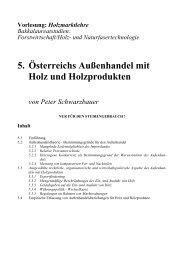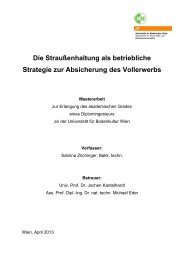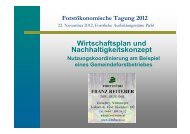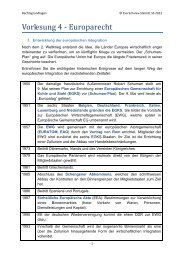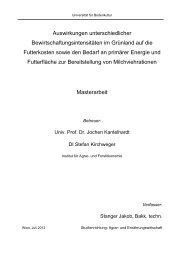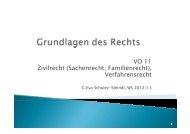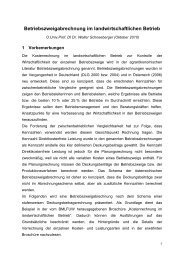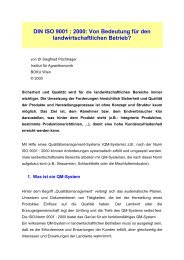Certification and Accreditation of Organics in Austria - Boku
Certification and Accreditation of Organics in Austria - Boku
Certification and Accreditation of Organics in Austria - Boku
Create successful ePaper yourself
Turn your PDF publications into a flip-book with our unique Google optimized e-Paper software.
16<br />
organic goods through the enterprise. Operators<br />
might prefer such cooperation to complete legal<br />
regulation (Browne et al., 2000).<br />
However, while <strong>in</strong>clud<strong>in</strong>g quality management systems<br />
at the trader <strong>and</strong> processor level are a promis<strong>in</strong>g<br />
approach, similar calls at the farm level (Bradley <strong>and</strong><br />
van Houten, 2000) do not seem helpful <strong>in</strong> <strong>Austria</strong>.<br />
Indeed, because most organic farms are family farms,<br />
the farmer has limited time <strong>and</strong> tra<strong>in</strong><strong>in</strong>g. Also, the<br />
farmer’s management decisions are highly dependent<br />
on unpredictable external factors such as the weather<br />
or market developments, mak<strong>in</strong>g it unlikely that a<br />
farm plan spann<strong>in</strong>g several years <strong>and</strong> cover<strong>in</strong>g both<br />
general management practices as well as plant<strong>in</strong>g<br />
patterns <strong>and</strong> animal husb<strong>and</strong>ry can be adhered to.<br />
Thus, the AMA presently requires crop plans only for<br />
the current year, s<strong>in</strong>ce these are necessary to calculate<br />
various direct payments.<br />
Consumers’ <strong>and</strong> Farmers’ Perspectives<br />
Limits <strong>of</strong> certification <strong>in</strong> ensur<strong>in</strong>g consumer<br />
confidence<br />
Because consumers may be buy<strong>in</strong>g organic products<br />
for reasons <strong>of</strong> health as well as environmental concerns,<br />
high pr<strong>of</strong>ile news stories <strong>of</strong> contam<strong>in</strong>ated or<br />
unsafe conventional food <strong>in</strong>crease the dem<strong>and</strong> for<br />
them. It is then crucial to preserve the credibility <strong>of</strong><br />
organic labels so as not to underm<strong>in</strong>e consumers’<br />
trust <strong>in</strong> organic products. <strong>Certification</strong> has a key role<br />
to play <strong>in</strong> ensur<strong>in</strong>g that <strong>in</strong>cidents similar to those<br />
reported from conventional foods do not occur <strong>in</strong> the<br />
organic food cha<strong>in</strong>.<br />
At the same time, the limits <strong>of</strong> certification as a way<br />
to prevent loss <strong>of</strong> consumer confidence must also be<br />
clear. Indeed, several legal provisions made to accommodate<br />
<strong>in</strong>dustry needs <strong>and</strong> <strong>in</strong>terests <strong>in</strong> a stilldevelop<strong>in</strong>g<br />
market are a potential source <strong>of</strong> consumer<br />
disillusionment. For example the AMA Market<strong>in</strong>g<br />
organic logo, <strong>in</strong> accordance with the EU Regulation,<br />
allows up to 5% <strong>of</strong> selected <strong>in</strong>gredients to orig<strong>in</strong>ate<br />
from conventional production, although the logo can<br />
be perceived as imply<strong>in</strong>g 100% organic. Also, if the<br />
product conta<strong>in</strong>s raw <strong>in</strong>gredients that cannot be produced<br />
<strong>in</strong> <strong>Austria</strong>, up to 30% <strong>of</strong> foreign organic <strong>in</strong>gredients<br />
can be used, although the logo implies an organic<br />
product <strong>of</strong> <strong>Austria</strong>n orig<strong>in</strong>. Although these<br />
provisions are necessary to allow some leeway for<br />
processors as long as the market cannot ensure a<br />
cont<strong>in</strong>uous supply <strong>of</strong> organic products <strong>of</strong> the required<br />
orig<strong>in</strong> <strong>and</strong> quality, most consumers are not aware <strong>of</strong><br />
them <strong>and</strong> may feel cheated. In addition, AMA<br />
Market<strong>in</strong>g was heavily criticized by environmental<br />
organizations <strong>and</strong> the organic movement for its<br />
choice <strong>of</strong> advertisements promot<strong>in</strong>g regional <strong>and</strong><br />
national labels that could be perceived by consumers<br />
as be<strong>in</strong>g organic although they are not.<br />
A similar unresolved issue is the fact that the EU<br />
Regulation stipulates that organic products must be<br />
GMO-free. However what “GMO free” means has<br />
not been clearly def<strong>in</strong>ed <strong>in</strong> many European countries,<br />
leav<strong>in</strong>g room for <strong>in</strong>terpretation. In <strong>Austria</strong> the limit<br />
for “GMO free” is 0.1 % <strong>of</strong> the total DNA with<strong>in</strong> the<br />
framework <strong>of</strong> “<strong>in</strong>evitable contam<strong>in</strong>ation,” which is<br />
not the zero-tolerance policy that consumers might<br />
expect.<br />
Another potential source <strong>of</strong> consumer <strong>in</strong>security are<br />
organic products reveal<strong>in</strong>g traces <strong>of</strong> prohibited<br />
chemicals. Because organic products are rout<strong>in</strong>ely<br />
stored next to conventional products, cross contam<strong>in</strong>ation<br />
is bound to occur, as is comm<strong>in</strong>gl<strong>in</strong>g when the<br />
two k<strong>in</strong>ds are processed <strong>in</strong> the same plant.<br />
Besides these issues based on legal tolerance marg<strong>in</strong>s<br />
<strong>and</strong> poor practices by processors <strong>and</strong> retailers, another<br />
source <strong>of</strong> confusion is mislead<strong>in</strong>g label<strong>in</strong>g. The<br />
EU Regulation states that words like “organic,”<br />
“ecological,” “biological,” <strong>and</strong> shortened forms like<br />
“bio” <strong>and</strong> “eco” must refer to organic production<br />
methods; if that is not the case, the matter might be<br />
h<strong>and</strong>led as fraud. This also <strong>in</strong>cludes all terms that<br />
might be understood by consumers as similar to the<br />
above mentioned terms, e.g. “controlled,” “<strong>in</strong>tegrated”<br />
or “natural.” This has led to a significant<br />
reduction <strong>of</strong> mislead<strong>in</strong>g <strong>and</strong> fraudulent advertis<strong>in</strong>g on<br />
the <strong>Austria</strong>n market. Nevertheless, several companies<br />
try to use the positive image <strong>of</strong> organic farm<strong>in</strong>g by<br />
design<strong>in</strong>g labels position<strong>in</strong>g their products close to<br />
the organics.<br />
This is especially true for companies with a trademark<br />
that conta<strong>in</strong> the terms “bio” or “öko” <strong>and</strong> that<br />
was registered before January 1, 1995. They can use<br />
this trademark until 2006, although it must be clearly<br />
mentioned on the product that it orig<strong>in</strong>ated from conventional<br />
farm<strong>in</strong>g. However this is not always enforced<br />
(Mergili, 2002). The likelihood <strong>of</strong> consumer<br />
confusion is particularly high if the br<strong>and</strong> sells both<br />
conventional <strong>and</strong> organic foods with little difference<br />
<strong>in</strong> package design.<br />
F<strong>in</strong>ally, confus<strong>in</strong>g label<strong>in</strong>g also occurs because several<br />
product groups, such as flowers, w<strong>in</strong>e, textiles,<br />
wild fish, <strong>and</strong> wild animals, are not <strong>in</strong>cluded <strong>in</strong> the



